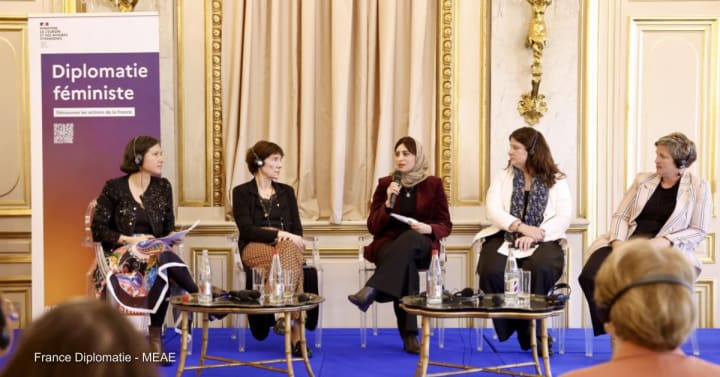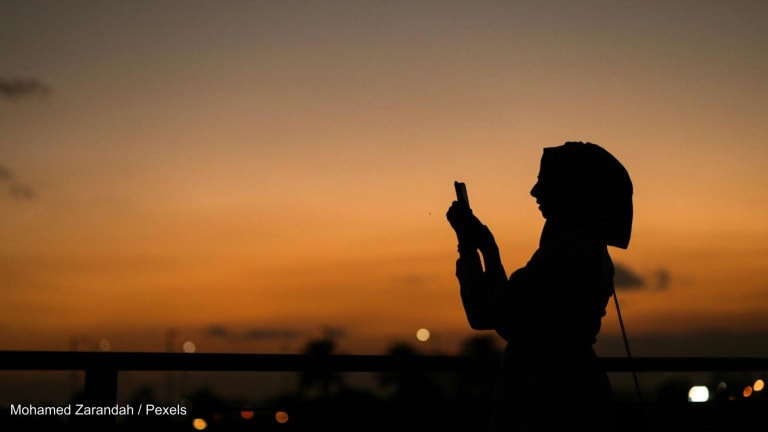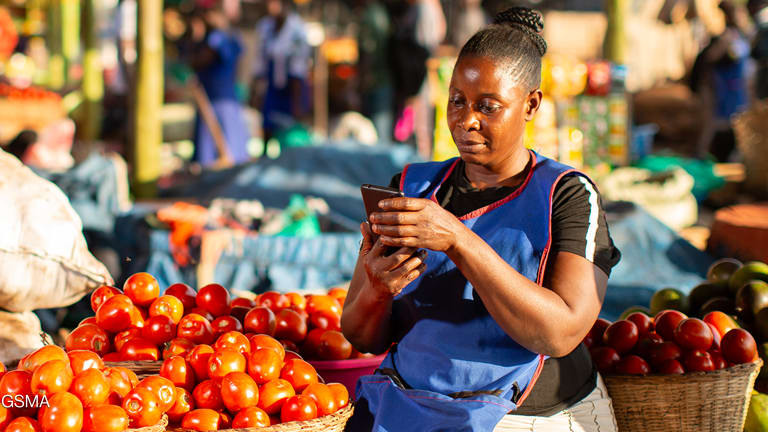
Last month, UN Women and Zenobia — a Syrian civil society organization supported by the Women’s Peace and Humanitarian Fund, or WPHF — were invited to speak at the launch of France’s international strategy for a feminist foreign policy. The event marked a key moment in reaffirming the centrality of gender equality and women’s rights across diplomacy, peace, and technology. It also offered a timely opportunity to reflect on how digital governance and peacebuilding intersect with the ambitions of feminist multilateralism.
Four years ago in Paris, UN Women and the government of France stood alongside global advocates to launch the Generation Equality Forum. This initiative aimed to accelerate global gender equality through collaborative, multistakeholder partnerships that would mobilize concrete commitments and increase investments to advance the Beijing Platform for Action. Our goal was ambitious: to build the world’s first multistakeholder Action Coalition on Gender, Technology and Innovation. We were driven by the conviction that the digital revolution will not advance justice and democracy unless it is feminist.
Since then, UN Women has worked across multilateral platforms to bring this vision to life. From the 67th session of the Commission on the Status of Women to the adoption of the Pact of the Future, we have placed gender equality at the core of digital policy.
We see three urgent priorities emerging from this work:
1. Digital access is a matter of rights, not privilege
The gender digital divide is a human rights issue. When women and girls are offline, they are cut off from education, health care, job opportunities, and civic life. Around 90% of adolescent girls and young women in low-income countries do not use the internet, while their male peers are twice as likely to be online. Bridging this divide is fundamental to any vision of inclusive digital transformation.
2. Technology should amplify voices, not silence them
Technology has been used to fuel insecurity and conflicts. Artificial intelligence has been proven to pose a risk to women’s security, be it through online harassment, misinformation, or disinformation. Technology-facilitated gender-based violence is rampant and escalates as new technology emerges, often with impunity. In a global survey, 73% of women journalists reported experiencing online violence in the course of their work and nearly a third said it led them to self-censor. Among young European women, half hesitate to participate in online debates after experiencing or witnessing abuse. This chilling effect on women’s expression and leadership in digital spaces has become a structural barrier.
3. Control of algorithms is power — and right now, it’s held by too few
The digital ecosystem is shaped by extreme power imbalances, with persistent gender asymmetries in representation and decision-making across both the tech sector and global governance. The rules are set, the platforms built, and the conversations driven predominantly by men from industrialized countries. This dynamic disproportionately harms marginalized communities, as technologies poorly fit their needs and exacerbate existing inequalities. Addressing this imbalance requires an inclusive approach to digital governance, with transparency and human rights safeguards built in from the start.
Our collective message is clear
Digital is the new frontier of women’s rights. Digital equality is essential for peace. This is why we are working to ensure that digital frameworks and initiatives reflect the realities of women and girls. This is a central pillar of the Beijing+30 review and WPHF has also integrated digital inclusion and safety as a cross-cutting priority in its Strategic Plan for 2023-2025.
The Women, Peace and Security agenda teaches us that when women are excluded from conflict prevention, peace processes, and peacebuilding, societies are less stable and conflicts more likely to reemerge. The same applies in digital spaces: When women are excluded — from access, from leadership, from safety — the result is a digital world that mirrors and magnifies existing injustices. The voices of feminist peacebuilders like WPHF grantees are reminders that security is not just about silencing conflict, it’s about enabling full, safe participation.
So what do we do?
We put people and human rights at the center of digital development. And we ask governments to do more than regulate: They must also invest, innovate, lead, and empower local players to co-shape responsible and equitable technologies.
We must stop pretending that technology is neutral. It reflects our histories, our choices, and our values. When chatbots reinforce gender stereotypes and predictive algorithms replicate discrimination, the problem isn’t the technology — it’s the worldviews they encode.
The digital revolution is accelerating and these technologies are evolving faster than any policymaker can keep up with. Instagram took years to reach 100 million users. ChatGPT did it in two months. No policy framework can evolve at that pace. But we can be intentional about the values we embed as we move forward.
Governments now have a critical opportunity to ensure that gender equality is not a side note, but a guiding principle. Governments have the opportunity to engage women-led civil society organizations in these processes. France’s new strategy offers a compelling example of how feminist foreign policy can shape a digital and peacebuilding action grounded in evidence, driven by rights, and accountable to those most affected. It identifies women’s rights in the digital environment as a key priority, and backs this commitment with concrete initiatives that demonstrate how member states can lead by example:
• The adoption of the first U.N. resolution on the elimination of violence against women and girls in digital spaces, co-led with the Netherlands.
• The AI Action Summit held in Paris in February 2025, which produced the first international statement on the consideration of gender equality in the development of AI, adopted by 12 countries.
• The Laboratory for Women’s Rights Online launched in 2024, which supports five innovative projects across continents aimed at assisting women affected by violence in digital spaces.
We are not facing a technical challenge — it is a political one. And the decisions we make today will define the digital future for generations.
Right now, we’re still trapped in systems designed for compulsive use, optimized for profit, and indifferent to harm. None of this is inevitable, but we are at a crossroads.
We can choose to build a digital future that is inclusive, safe, equitable, and empowering for all. The Global Digital Compact offers that path. But it requires action — not tomorrow, not in 10 years. Now.
Our digital future is being decided as we speak. It is time to make the digital world work for everyone. As U.N. Secretary-General António Guterres reminded us on International Women’s Day 2025: Gender equality cannot wait. Peace cannot wait. Take a look at the actions you can take to accelerate gender equality for ALL women and girls.
Visit Ctrl Shift Equality —a series exploring how to tackle the digital divide and technology-facilitated gender-based violence.
This content is sponsored by UN Women as part of the Ctrl Shift Equality series. To learn more about this series, click here.






